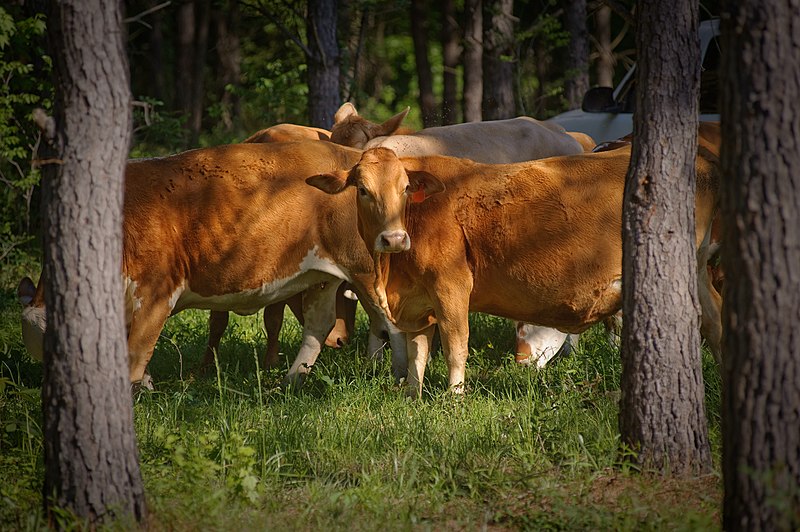Imagine you’re standing in a forest in the Piedmont. Oak and pine trees of different heights sway above you as long grasses, deep purple violets, and the vibrant yellow flowers of golden ragwort brush your ankles. As you walk between the wide rows of trees, cattle and sheep graze beside you. You breathe in and smell the earthy mixture of compost and forest soil. You keep walking and hear the chorus of grass being pulled from the ground in many bite-sized clumps. Goats browse the blackberry, multiflora rose, and other shrubs, their hooves knocking against tree trunks as they reach for higher brambles. Trees stand tall around pigs as they root through the dirt, turning the soil and building the aroma of earth around you. This combination of livestock and forests may not be the first thing that comes to mind when you think of livestock production or forestry, but it is actually a common method of agroforestry that strives to mutually benefit forest and farm ecosystems as well as the people who manage them.
Silvopasture is a way of mixing forestry and farming by adding trees to pastures, or grazing livestock in specially managed forests. For thousands of years before the first Europeans arrived, the Woodland peoples living in the Piedmont used fire for a multitude of reasons ranging from plant cultivation, medicine, and basketry – and most notably to alter the landscape for game and wildlife management as well as agricultural production. Their use of fire in this way helped the prairie land to thrive, providing foraging grounds for hunted game both in open prairies and along the forest edges. Plants and wildlife eventually evolved adaptations to survive in these fire-dependent communities. By mimicking already naturally occurring fires, the Woodland people managed the region’s native savanna ecosystems to provide for their needs and created a blueprint for silvopasture that is still practiced today.
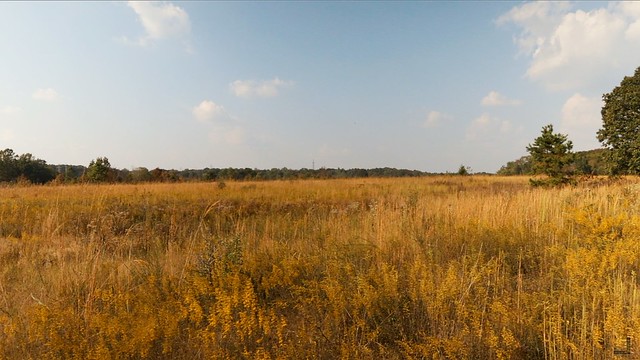
The Piedmont was once covered in savanna. Indigenous peoples made use of this landscape and mimicked naturally occuring fires to manage savanna for grazing animals. This management practice created the blueprint for silvopasture today. Credit: Public Domain
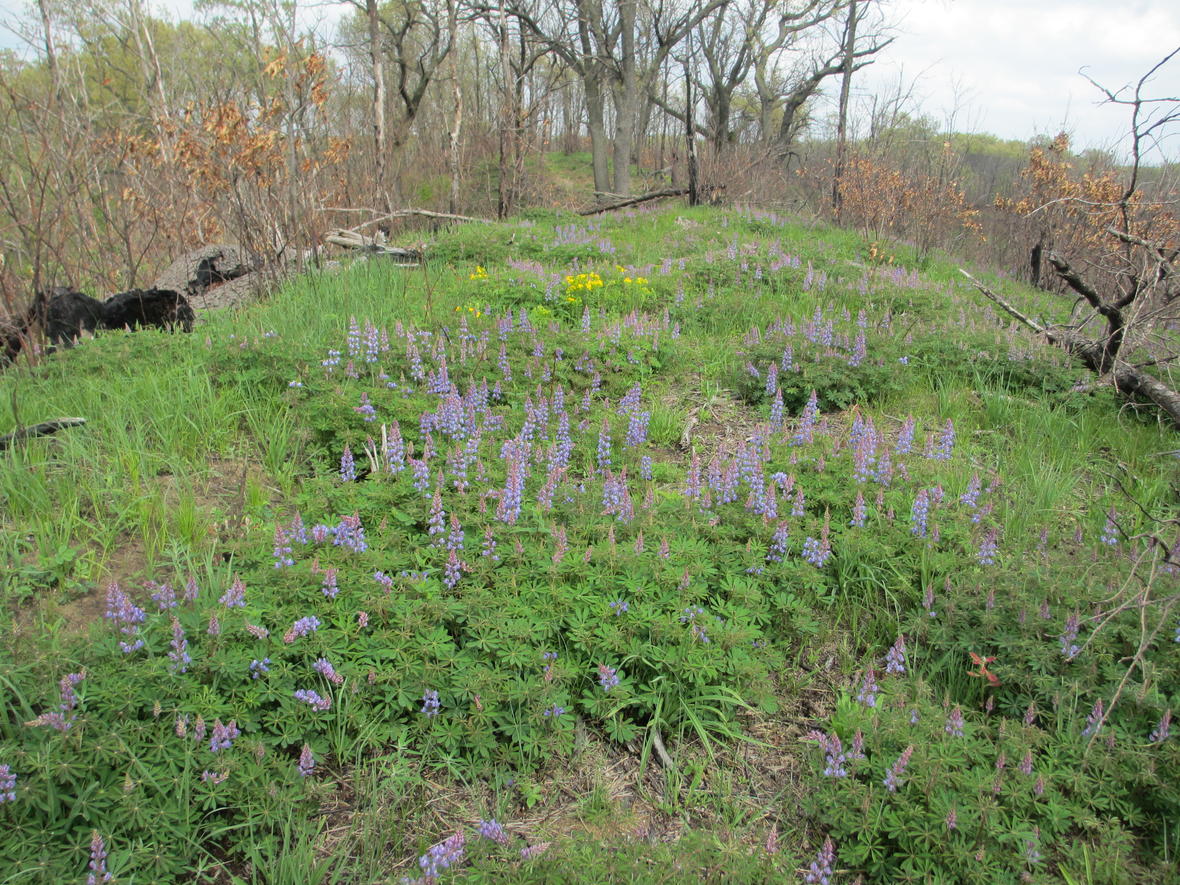
Savana when translated means “land which is without trees but with much grass either tall or short.” It is derrived from an Indigenous word first used in a written publication in 1535 and was expanded in the late nineteenth century to include grassland with trees. Credit: Public Domain
Contemporary silvopasture, practiced on around 15% of the world’s grazinglands, combines trees, forage plants (grasses and other low growing plants), and livestock in an intensively managed system that produces food and other agricultural products, along with many other environmental and economic advantages. The plants and livestock used on silvopasture farms vary with region, local environmental conditions, and potential market value of products.
Cows, pigs, chickens, goats, and sheep are all used in various silvopasture operations as well as some less commonly seen animals like ostrich and emu. Each animal group provides a unique service to the ecosystem and requires the right pairing of forest land and forage to create mutually beneficial relationships.
Pigs root through oaks for fallen nuts, mushrooms and plant roots, turning the soil as they go. Sheep are often paired with Christmas trees, other hardwood pine trees, and more recently with pastures full of solar panels on solar farms. Cattle are paired with many different forest types as well. Sheep and cattle work well in these silvopasture systems, because they are natural grazers, so they are less likely to damage the trees by eating new new tree growth.
Goats are often used to clear land that has been overgrown with invasive plants like kudzu or multi-flora rose. Natural browsers, goats have a unique ability to eat almost anything, making them a perfect match for overgrown land in need of clearing. Pigs, chickens, ducks, quail, and geese are a good match for fruit and nut orchards, eating grubs and other bugs, and gleaning fallen fruit and nuts that may harbor pests and would otherwise rot. As with any system, there is a delicate balance between benefit and overuse. Allowing enough space for the animals and rotating them regularly is key to the sustainable management of silvopasture systems.
There are two common methods for incorporating silvopasture in farming and forestry operations. The first is to introduce livestock into already existing forest land or orchards. Within this method, trees are often thinned to provide enough light for forage production and the comfort of the livestock. The second is to add trees and shrubs to open fields in farmland. In this method, trees are planted farther apart than they would be in a woodland to allow for ample sunlight to produce good grazing for livestock. Faster growing trees like locust, alder, willow, and poplar are often used in temperate areas to establish a new silvopasture farm because they grow quickly to a size that will not be harmed by livestock. This allows for a quicker product yield while maintaining an appropriate tree choice for the region.
Silvopasture provides many different benefits to the livestock, forest ecosystem, farmers, and foresters and the surrounding community. Trees reduce weather-related stress for livestock by providing shelter hot and cold temperatures, high winds and severe storms, as well as areas to scratch and hide. Pigs, chickens, ducks, and other fowl forage for grubs and insects in the understory which reduces the need for grain and providing a healthier and more balanced diet. Livestock foraging fallen and dropped fruit and nuts provide them with additional sources of unique nutrient-rich foods with the bonus to the farmer of a hands-off post-harvest clean-up!
In return for all this, animals produce manures that can increase soil health by adding organic matter and nutrients to the forested areas. Planted grasses and other low-growing plants help with soil quality as well! They add organic matter and protect the soil from water and wind erosion. Silvopasture can also promote greater wildlife diversity both on the farm or in the forest by providing new high quality habitat through the introduction of more plant biodiversity. And last, but not least, silvopasture can also benefit the planet by reducing CO2 emissions and sequestering carbon.
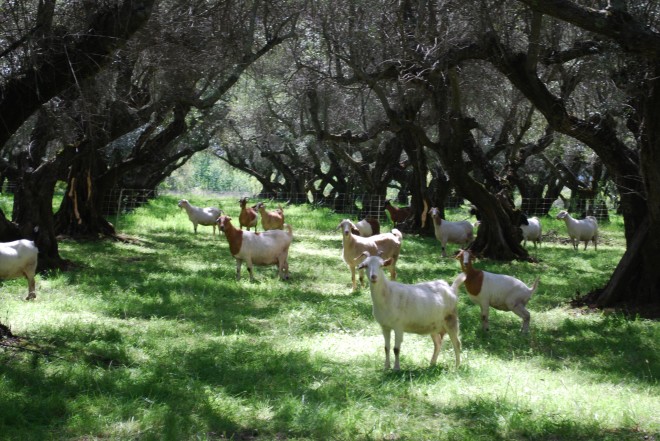
Goats graze in an olive orchard at Chaffin Family Orchards. Located in Northern California, Chaffin Family Orchards is a third generation family farm that uses permaculture practices. In addition to the Mission Olive trees pictured above used to make olive oil, they grow apricots, cherries, peaches, figs, avocados, pomegranates, pears, persimmons, manderins, oranges, grapefruit, and lemons! They also incorporate cattle for beef. Image Credit: Nourished Kitchen.
When designing a silvopasture farm or forest, making sure you pick the right species for the job is key. Selecting trees that are well adapted to regional environmental conditions and your local landscape and matching them to the appropriate livestock is central to a successful silvopasture design. Some species that are well adapted to Piedmont environmental conditions are loblolly pine and other conifers, poplar, and locust. Black walnut, chestnuts, and other fruit and nut trees are also commonly grown in the Piedmont to produce valuable nuts and fruit crops. The wider tree spacing required for silvopasture has some additional benefits, for example, reducing the risk of fire and producing a higher quality timber product because of reduced competition between trees. Grasses and other low growing plants good for grazing are typically planted to benefit the growth of the livestock, and in some cases to encourage native wildlife. Legumes, plants that fix nitrogen like clovers, enrich the soil and provide high quality feed for livestock are commonly grown in the Piedmont region. Other perennial grasses like fescue and switchgrass are also recommended for grazing animals in our region. When combined with the returns made through the sale of meat, eggs, and other animal products, this integrated system can be a highly lucrative agricultural enterprise.
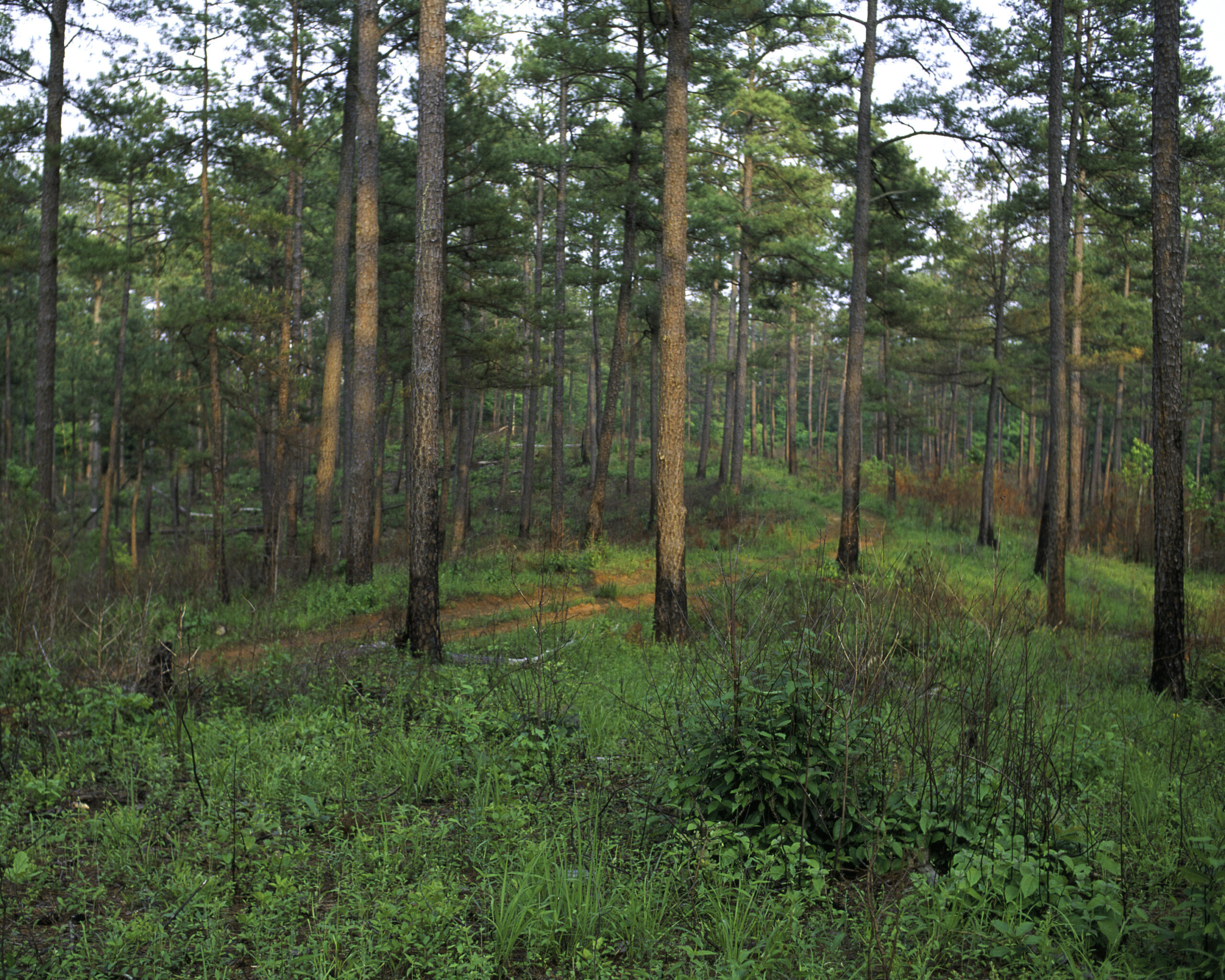
Pine tree species like loblolly and slash pine are most commonly used in silvopasture management in the Piedmont. Shortleaf pine, pictured above, is slower growing and makes for a longer wait time to introduce livestock into the forest stands. However, shortleaf pine is beneficial and important to the region in many ways and the introduction of silvopasture can add even more benefit in a more mature stand. At Catawba Run, we plan to introduce silvopasture into our recently planted shortleaf pine stands after the trees have reached appropriate maturity. Image Credit: Public Domain
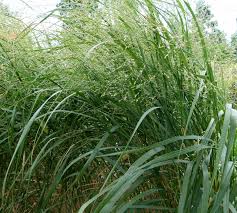
Switchgrass pictured here is a warm season forage that is commonly used in silvopasture management in the piedmont. Image Credit: Public Domain
In Goldsboro, North Carolina, silvopasture is being put into practice at the Cherry Research Farm operated by the Center For Environmental Farming Systems (CEFS). Their 17-acre silvopasture project, conducted on a site that had repeatedly failed to produce good corn and soybean yields, is just one example of the benefits of modern silvopasture in and around the Piedmont region of North Carolina. Because trees and perennial grasses are more resilient when it comes to flood and drought, researchers at CEFS decided to transition the land into silvopasture.
Longleaf pine, loblolly pine, and cherrybark oak are all planted in a diamond formation across a variety of soil types. Native warm-season grasses were planted in the understory including big bluestem, eastern gamagrass, Indiangrass, and switchgrass. Although the trees were planted back in 2007, livestock were not added to the site until 2016. This gave the trees time to grow and lowered the risk of damage by the introduction of animals. Both the tree species and grasses were selected because they are native species and will produce high quality products. Black Angus cattle graze through the forest during the summer months. This project provides demonstration for local farmers while producing useful scientific data related to crop yields, ecosystem health, animal health, and carbon sequestration. CEFS staff are also happy to provide information and consult with local livestock producers and forest owners interested in thinking about trying silvopasture on their land.
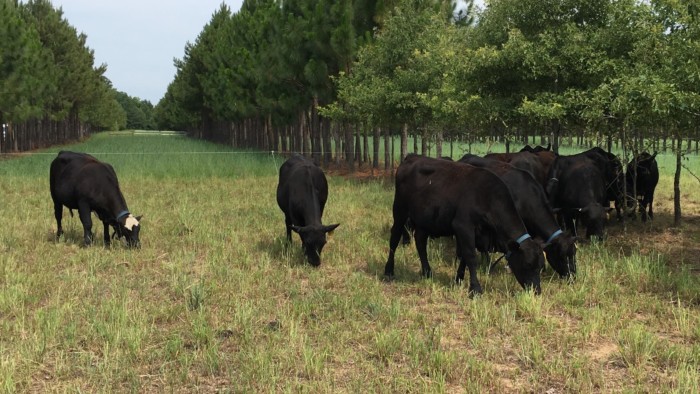
Angus cattle graze on native warm season grasses through longleaf pine, loblolly pine, and cherry bark oak on the Cherry Research Farm. Image Credit: CEFS
No matter the scale, a farm, a forest or a homestead, silvopasture can be a resilient food production option in the Piedmont. A few hours South East of Catawba Run, right outside of Gastonia, NC rests the Piedmont Homestead,where you can find Mike and Kristina growing organic produce to sell at farmers markets in their region. Using woodland and pasture, they also raise chickens for eggs and meat. Their Golden Comets graze through wooded areas for 2-3 weeks and are then rotated to new sections of the farm. They use the chickens to prepare the wooded areas for planting perennial grasses and forages in the summer to improve the silvopasture habitat. Even at their small scale of 1/8 of an acre, the use of silvopasture yeilds benefits for the land, the farmer, and the animals that live there!
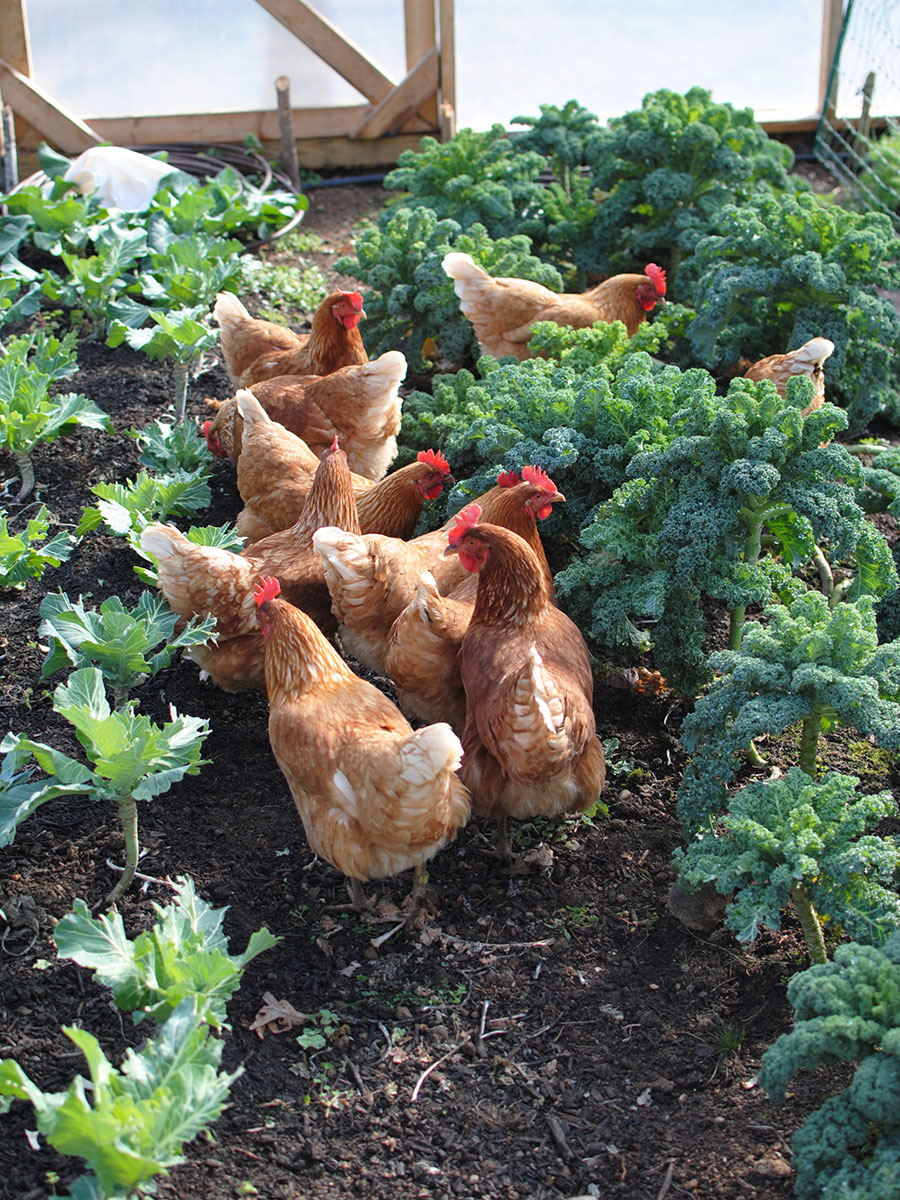
Laying hens pick through kale at The Piedmont Homestead. Image Credit: The Piedmont Homestead
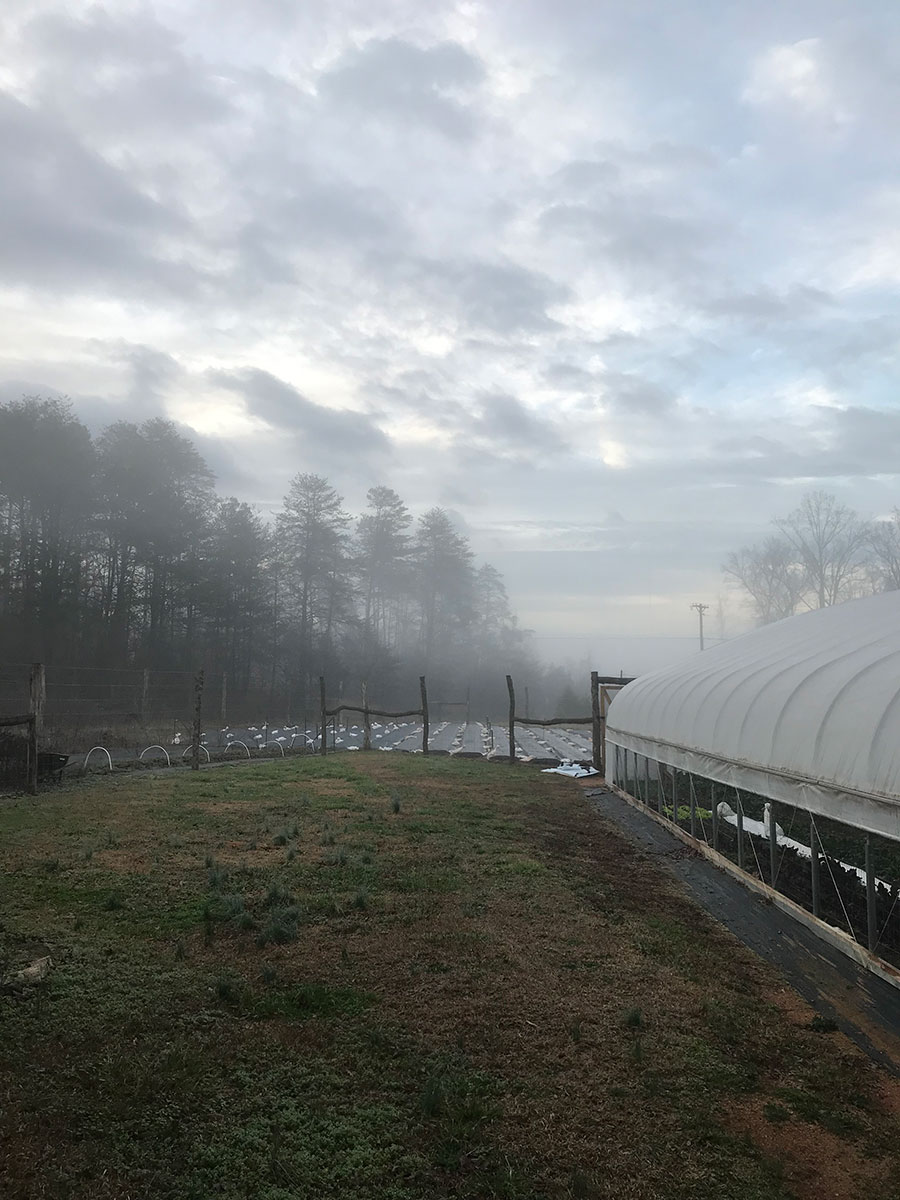
The Piedmont Homestead on a foggy morning. Image Credit: The Piedmont Homestead
In the Midwest, farmers are taking silvopasture to larger, more commercial scales of production. Forest Ridge Farms has been raising hogs since the 80s. While they started out with a more typical farming method of feeding grain to pigs living in enclosed pens, they have since discovered the benefits of producing pigs in silvopastures. Their pigs forage through oak savannas to enjoy an abundance of acorns, beech nuts, tubers, roots, wild herbs, and forages. The pigs are offered additional feed as needed, but mostly they take full advantage of what the land has to offer. They believe that stress free animals make for better tasting meat. With over 45 pork products, they deliver for free locally and ship out of state as well. Forest Ridge Farm is an example how typical livestock methods and farms can evolve and move into a more resilient future through the use of silvopasture!
The Savanna Institute works to “catalyze the development and adoption of resilient, scalable agroforestry.” Based in the Midwest, they offer an array of resources highlighting different agroforestry techniques that are being used on farms and ranches throughout the region.
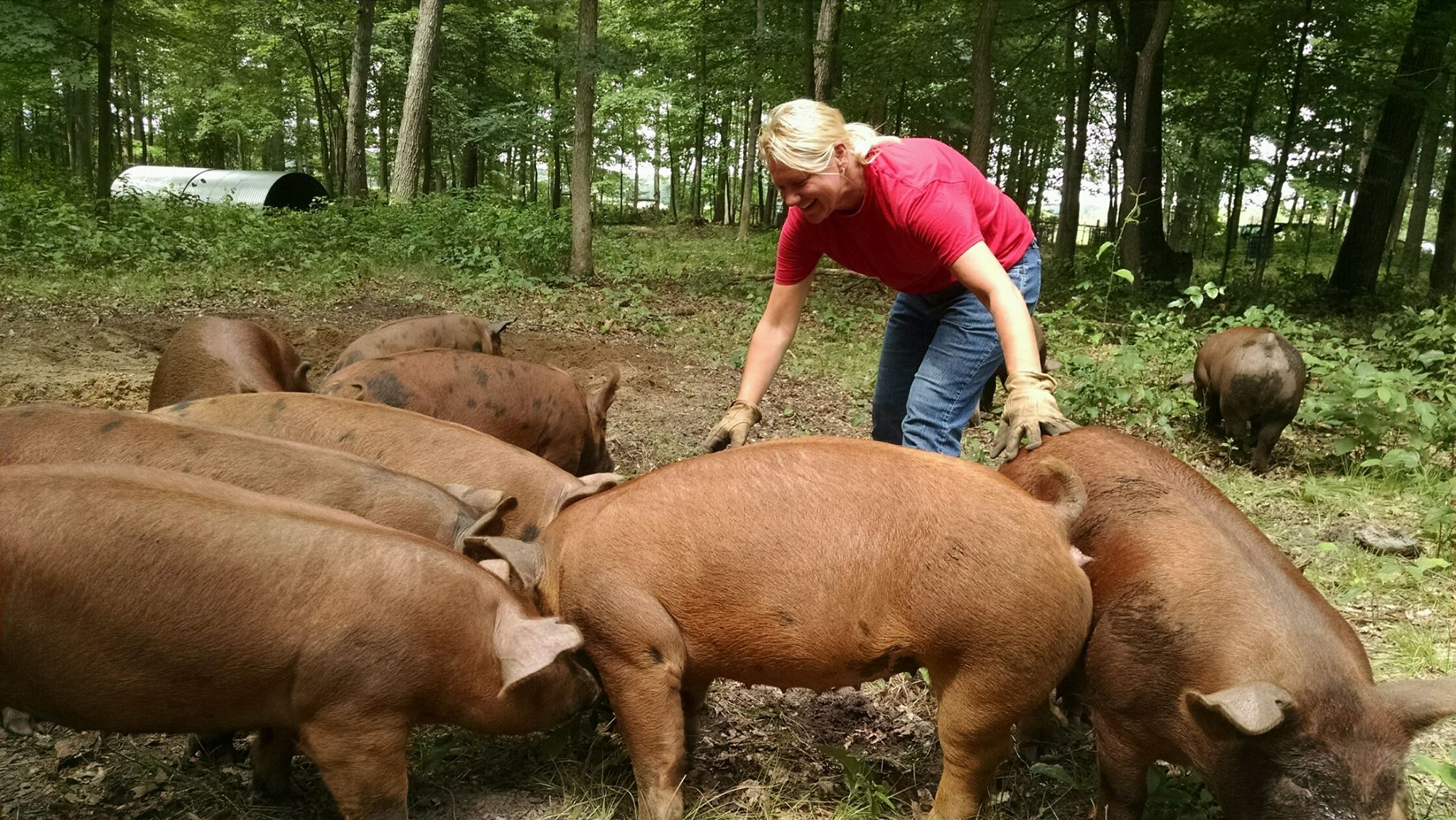
Bonnie of Forest Ridge Farms and the heritage bred pigs. Image Credit: Forest Ridge Farms

Hogs at Forest Ridge Farms moving through their silvopasture paddock. Image Credit: Forest Ridge Farms
Silvopasture is one of the top 10 solutions to climate change according to Project Drawdown – an international project to identify the most cost effective ways to reverse climate change. Silvopasture is an effective climate change solution because the trees and grasses in the system promote biological sequestration, a natural process that removes CO2 from the atmosphere and stores it in plants and soil. Put plainly, more silvopasture equals less CO2 in our planet’s atmosphere. At every scale, silvopasture can impact not just the farm, forest, and animals but the planet as well. As a top ranked climate change solution that also produces healthy, high quality foods, silvopasture provides anyone managing agricultural land a unique opportunity to make a larger impact on the planet as a whole. The resources offered by CFFS and the Savanna Institute, along with the lessons being learned by the homesteaders and farmers already using silvopasture in the Piedmont and beyond, means that anyone can get the help they need to give silvopasture a try.
Here at Catawba Run, we’ve got big plans for silvopasture. In a few years, as you walk down the forested paths, listening to the river and watching the native pollinators buzz along the forest edges, you’ll notice grazing animals in the distance between the trees. As you walk closer, you’ll see that between stands of loblolly and slash pine sheep and goats graze on healthy stands of grasses and other low growing plants thriving between the trees, generating a multitude of benefit to the lands and waters of Catawba Run, and reminding us of the link between the Native peoples of the Piedmont and the origin of silvopasture.
Silvopasture is one type of agroforestry – a broader term that simply means mixing trees, shrubs, and farming systems together. While agroforestry methods of all kinds can benefit farms and forestland, silvopasture has the unique quality of incorporating livestock and animal production. Allowing animals to enhance the natural environment rather than deplete it, while maintaining their quality of life is a great example of how farmers and homesteaders alike can cultivate resilience. As a top ranked practice that can greatly impact climate change, silvopasture provides a unique opportunity to make a larger impact on the planet as a whole. With projects like CFFS and Catawba Run providing demonstration and resources for farmers and foresters in the region, the Piedmont can begin to take small steps towards that growth. Whether it is silvopasture demonstration at Catawba Run or CFFS, or small-scale production like Piedmont Homestead, silvopasture can provide benefits to the land, animals, and people who interact with it by creating habitat, building soil, conserving water, enhancing forest health, providing ample shade for livestock, and making efficient use of space for a multi-product enterprise of timber and animal production!
Catawba Run is 275 acres of old growth, unmanaged regrowth, and sustainable pine plantation located in the Piedmont region of North Carolina, near Nebo, just west of Morganton. This land is the setting for Foragable Community’s next demonstration of our shared values: to use ecological management practices and resilience principles to restore the health and wellbeing of degraded landscape, and concurrently have a positive impact on the lives of people who participate in this vision of redemption and renewal.
The Catawba Indian Nation are the descendants of the original inhabitants of land that we call Catawba Run. The Catawba, or “the people of the river” pronounced yeh is-WAH h’reh in their native tongue, were farmers, renowned potters, and stewards of the land in most of the Piedmont of South Carolina, North Carolina, and Southern Virginia. Foragable Community acknowledges that Catawba Run is on this ancestral land.
Sources
Fairchilds, Lindsay H.; Trettin, Carl C. 2006. History and legacy of fire effects in the
South Carolina piedmont and coastal regions. Gen. Tech. Rep. SRS–98 Asheville, NC: U.S.
Department of Agriculture Forest Service, Southern Research Station.
Why Burn. eFIRE, North Carolina State University.
Gabriel, S. (2019, June 11). Six Key Principles for a Successful Silvopasture. Cornell Small Farms Program, College of Agriculture and Life Sciences.
Silvopasture. National Agroforestry Center, Department of Agriculture.
Nargi, L. (2019, January 08). Silvopasture Can Mitigate Climate Change. Will U.S. Farmers Take it Seriously?
Beacom, M. (2016, September 01). Silvopasture getting closer look in Southeast.
Carlson, T. (n.d.). Silvopasture.
Juras, P. M. (1997). The presettlement piedmont savanna: A model for landscape design and management (Unpublished master’s thesis).

